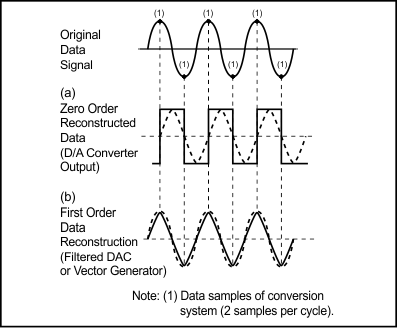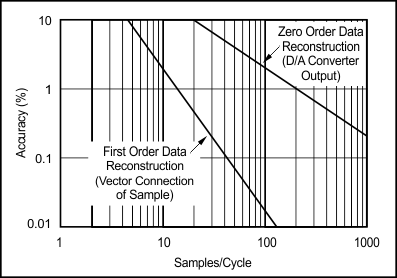SBAA051A January 1994 – April 2015 MSC1210Y2 , MSC1210Y3 , MSC1210Y4 , MSC1210Y5
1.3 How Many Samples per Cycle?
The answer to this question depends on the allowable average error tolerance, the method of reconstruction (if any), and the end use of the data. Regardless of the end use, the actual error of the discrete data samples will be equal to the throughput error of the data acquisition and conversion system plus any digital errors contributed by a digital computer or other digital end device.
For incremental devices such as stepping motors and switches, the average error of sampled digital data is not as important as it is for end devices that require continuous control signals. To illustrate average sampling error in sampled data systems, consider the case where the minimum of 2 samples per cycle of sinusoidal data are taken, and the data is reconstructed directly from an unfiltered D/A converter (zero-order reconstruction). The average error between the reconstructed data and the original signal is one-half the difference in area for one-half cycle divided by π , or 32% for zero order data, and 14% for first order reconstruction. However, the instantaneous accuracy at each sample point is equal to the accuracy of the acquisition and conversion system, and in many applications, this may be sufficient for driving band-limited end devices. The average accuracy of sampled data can be improved by (1) increasing the number of samples per cycle; (2) presample filtering prior to multiplexing, or (3) filtering the D/A converter output.
 Figure 3. Reconstruction of Sampled Data Where fS = 2fMAX
Figure 3. Reconstruction of Sampled Data Where fS = 2fMAX The improvement in average accuracy of sampled data is dramatic with only a slight increase in the number of samples per cycle as shown in Figure 4. The theoretical limit is the throughput accuracy of the acquisition and conversion system for continuous sampling.
 Figure 4. Reconstruction Accuracy vs Number of Samples Per Cycle
Figure 4. Reconstruction Accuracy vs Number of Samples Per Cycle For zero order reconstruction of data, it can be seen from Figure 4 that more than 10 samples per cycle of data bandwidth are required to reconstruct sampled data to average accuracies of 90% or better. A commonly used range is 7 to 10 samples per cycle.